In 2016, Wizards of the Coast released The Art of Magic: the Gathering - Zendikar, an art book containing incredible story information and illustrations about the world that served as the backdrop for the then-newly released MTG set, Battle for Zendikar. In parallel, the book author James Wyatt — already known for several works on Dungeons & Dragons — has published Plane Shift: Zendikar, a free online PDF supplement of D&D 5th Edition rules for the respective plan, originally designed for Magic. It was the first time that Wizards of the Coast had put its name on a crossover between its two greatest brands, although the content had not been tested and therefore could not be considered "official".
Still, the supplement was very well received — as Magic and D&D are both games that explored compatible concepts of medieval fantasy, and the number of people playing both has always been a sizable niche. The Plane Shift series continued following the later MTG releases and their respective artbooks, through Innistrad, Kaladesh, Amonkhet, Ixalan and Dominaria, until culminating in the release of the first official campaign supplement for D&D with Guildmasters' Guide to Ravnica in 2018.
Unfortunately, due to author James Wyatt's feasibility of time and energy, the Plane Shift series was discontinued after Dominaria. While other official D&D materials were later released still taking advantage of Magic settings — Mythic Odysseys of Theros and more recently Strixhaven: a Curriculum of Chaos — not all the new planes visited in Magic: the Gathering since so they could have their respective adaptations for D&D. This is a shame for me, as overall, I consider the work of the WotC designers involved in creating these worlds to be really excellent. Many of these planes would make for incredible campaign settings, and it would be wasteful not to take advantage of them.
With that in mind, I decided to use the space we have here at Cards Realm to try to make a simple contribution in this regard, bringing content designed for someone who, like me, is passionate about both Magic and D&D. The idea is to try — with all emphasis on the word — to emulate James Wyatt's idea with the Plane Shift series and bring D&D 5ed rules to play in MTG planes. As we are in the midst of Kamigawa: Neon Dynasty, I thought it would be convenient to start with this world.
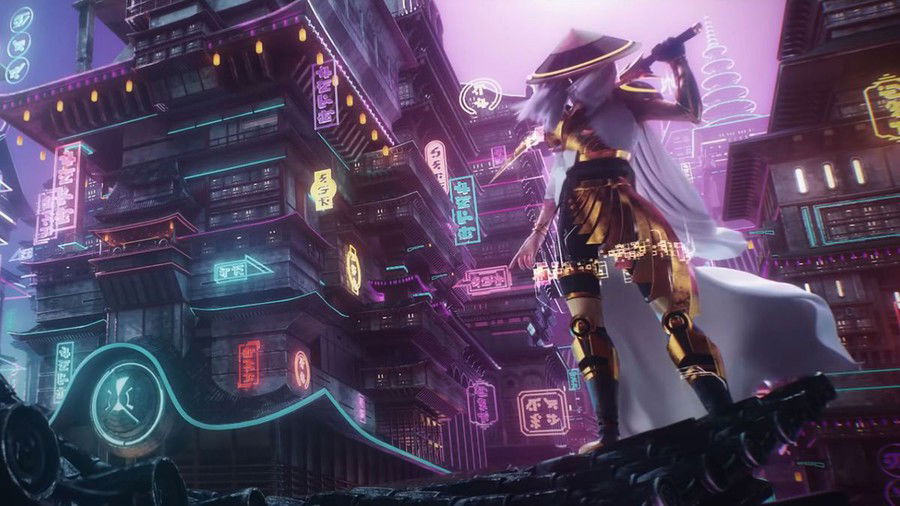
I know it's kind of obvious to say this, but it's always good to point out to leave no doubt: the content you'll find in these articles is a Homebrew; which means it didn't pass a thorough playtest. With that in mind, I tried not to change too drastically any element inherent to the already established rules of D&D 5th Edition
All I did was adapt rules and concepts already presented in official books to the theme of the scenario in question. I also took the liberty of looking for references in homebrew creations by others in the community, giving credit to them whenever possible. My intention with this material is not to reinvent the system, but to offer tools to better set D&D adventures in Kamigawa or eventually in any other themed setting that mixes Cyberpunk elements and Japanese culture.
Kamigawa's World
Kamigawa is a sci-fi setting heavily inspired by Japanese culture and aesthetics. Here samurai and ninja coexist with magic and high technology, employing cybernetic implements, nanotechnological weapons and giant mech robots. It is a futuristic setting in the best cyberpunk style, but still with several elements of a high fantasy typical of already acclaimed D&D settings.
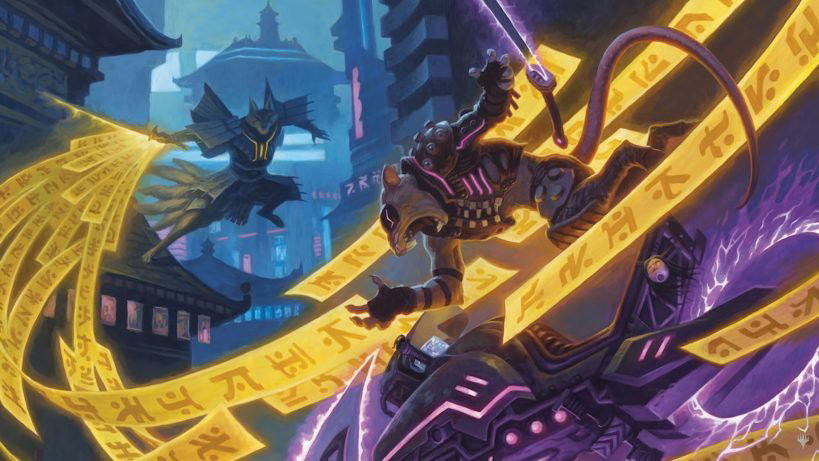
The central theme of the setting in Kamigawa is the conflict between tradition and modernity. For ages, this world has been governed by the metaphysical interaction between the physical realm (the Utsushiyo) and the spiritual realm (the Kakuriyo). The spirits—called Kami—were revered as the gods of mortals, bestowing wisdom and fueling the magic of wizards, clerics, and druids in the physical world with their spirit energy. Everything changed when mortals learned to extract the power of the Kakuriyo without the help of the kami through artifice, generating energy that would power their machines and plunge the world into an unprecedented technological revolution.
Cities have developed to the point of becoming major urban centers. The largest and foremost of these, Towashi, grew into the center of the world, rapidly devouring the Jukai Forest as it expanded. Some kami adapted to the new reality and integrated themselves into the new lifestyle of mortals heavily supported by technology; others began to feel threatened by their progress. Enraged, these kami fought, emerging from the depths of the forest to destroy the newly constructed buildings and curse the builders.
The Emperor — the highest authority among mortals in Kamigawa — intervened at the time, when the escalating conflict threatened peaceful relations between mortals and kami, negotiating a deal that the city would halt its growth into the forest. Meanwhile, the kami would not attack the city or interfere in its planning. City builders could continue to develop whatever land they had already begun to build on, with one exception: they were prohibited from cutting down Boseiju — the oldest sacred tree in the forest — which had fallen into the city's grasp during the construction and fighting. Also, the Jukai Forest was now closed to all mortals who didn't have the kami's permission.
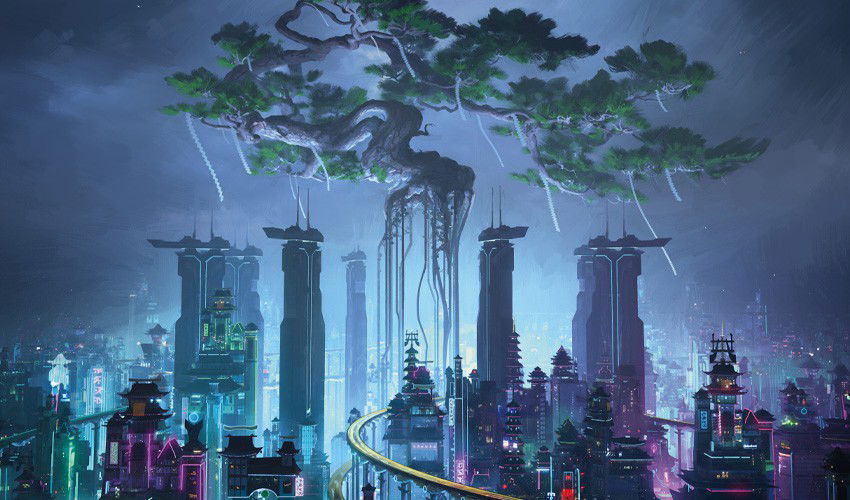
Kamigawa today lives under the strain of a new impending conflict between technocratic progressivism and traditional spirituality. The spiritual and physical realms—which once had well-defined boundaries—are merging and are likely to one day become one. More and more kami cross the barrier and enter Utsushiyo and no one knows what impacts this progressive conjunction will have. The Imperial Court, the highest authority in the world, strives to maintain friendly ties between mortals and kami, employing diplomats and creating regulations to try to stem the rampant advance of technology. Meanwhile, technocrats and revolutionaries often contest and flout imperial laws because they represent a setback to development and make it difficult to access the benefits of technology.
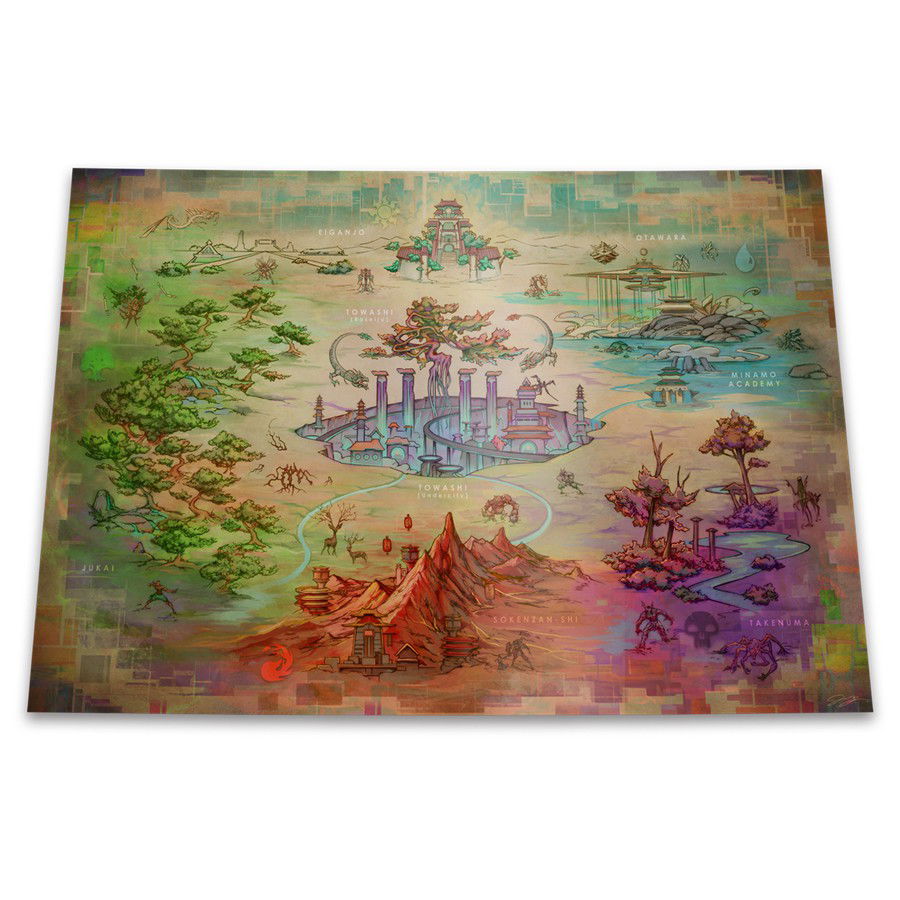
You can check out more details about Kamigawa's backstory in this post that I published last month, in addition to from stories from the Kamigawa sagas
and from Planeswalker Guide to Kamigawa: Neon Dynasty
on the Wizards website.
The Kami
The kami are the inhabitants of Kakuriyo, who frequently manifest in the physical realm. In Kamigawa they are the spirits who associate with all things in the world and are objects of fascination, admiration and fear to mortals. In numerous instances, they assume the role of supernatural beings of considerable power and may be revered as deities by kamigawans, but may live directly with their subjects. The most powerful and respected of the kami today is Kyodai, Soul of Kamigawa, who resides in a prominent temple in the upper city of Towashi, close to the Imperial residence.
The Kami exists in an incredible variety of forms and species. Although they are widely referred to as spirits, they can possess tangible physical appearances when manifested in Utsushiyo. In game terms, any supernatural creatures such as aberrations, celestials, dragons, elementals, fae, and fiends are considered kami in Kamigawa.
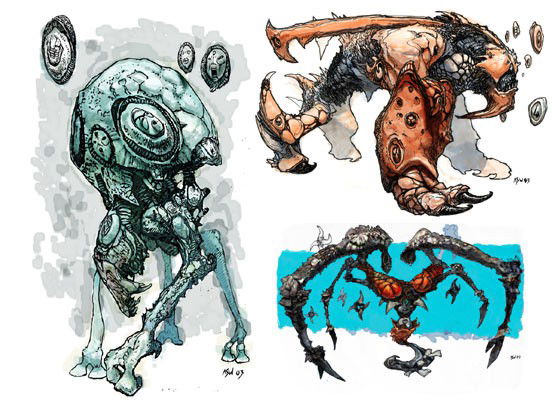
Magic and Technology
In Kamigawa, all magic comes from the spiritual energy coming from Kakuriyo, the spirit world. Divine spellcasters can access it through the reverence and empathic connection they have with the kami. In the past, arcane spellcasters also needed to channel the power of kami (albeit differently than clerics and druids) and therefore had a fair degree of dependence on these spirits to fuel their powers.
Since few people had close relationships with the kami, magic was restricted to a small elite and was inaccessible to the vast majority of the population. But that changed after the industrial revolution that came with the Modern Age, when mortals discovered ways to leverage and extract power directly from the spiritual realm and transform it into energy, only through technological devices.
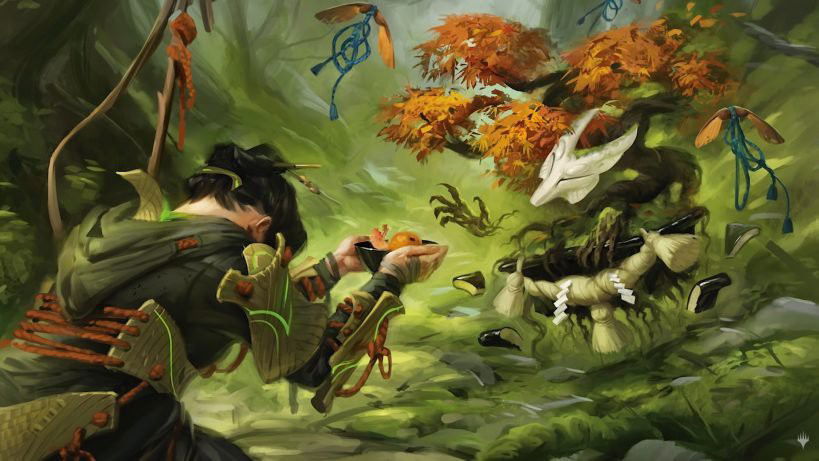
Since then, magic has become much more accessible and, in a way, even banal, assuming a much more present role in people's lives regardless of social class. The dependence on the relationship with the kami no longer exists, having been replaced by technology. In this way, magic and technology are confused in Kamigawa, in such a manner that the distinction between the two is blurred and largely ignored.
Wizards, sorcerers, warlocks, and bards use electro-mechatronic devices to alter reality at will, and artificers rely solely on engineering to produce fantastic effects. Whether the magic comes from them or the technology they use is up for debate, but the fact remains that nowadays nobody in Kamigawa cares as much to know. Technology is so pervasive in everyday life that for most people it is impossible to dissociate it from the simplest tasks.
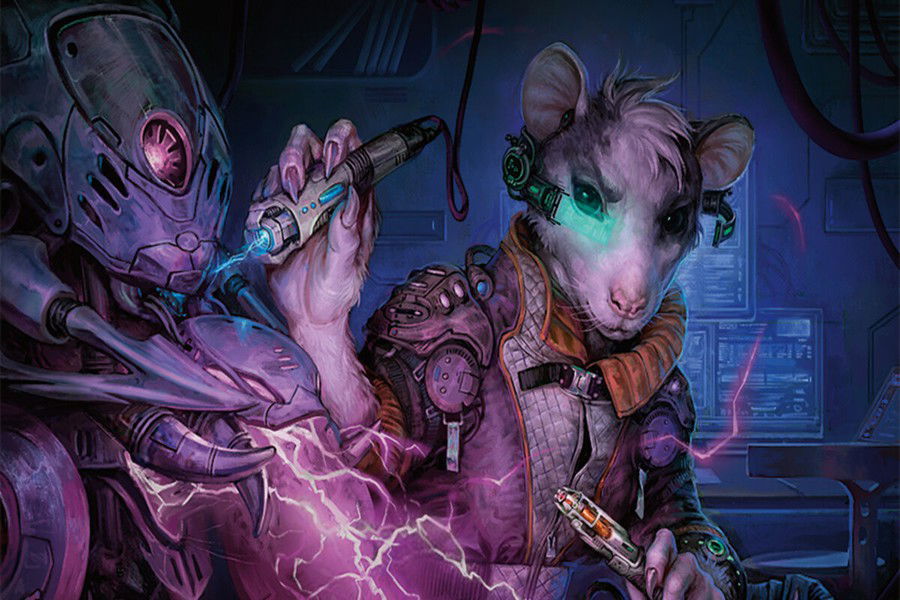
As for gameplay, technology in Kamigawa takes on the same role as magic in any other D&D campaign, with the difference that it is much more accessible and commonplace. An illusionist casting a silent image in a classic fantasy setting would make mystical gestures and words, whereas in Kamigawa he would likely use some sort of hologram or rear-projection. Still, there are those with access to magic who retain traditional methods of accessing spiritual power through a special relationship with the kami.
In general, the most tech-oriented spellcasters are arcane, while the most orthodox are divine; but this is not a rule for any of the cases. Many kami not only adapt well to technology but are also born out of it, so an integration between both ways of accessing magic is very common. Most people in Kamigawa are open to mixing it up as they see fit (although in general the technology is much more accessible than the kami). Only the most radicalized mortals and kami completely reject one method or the other.
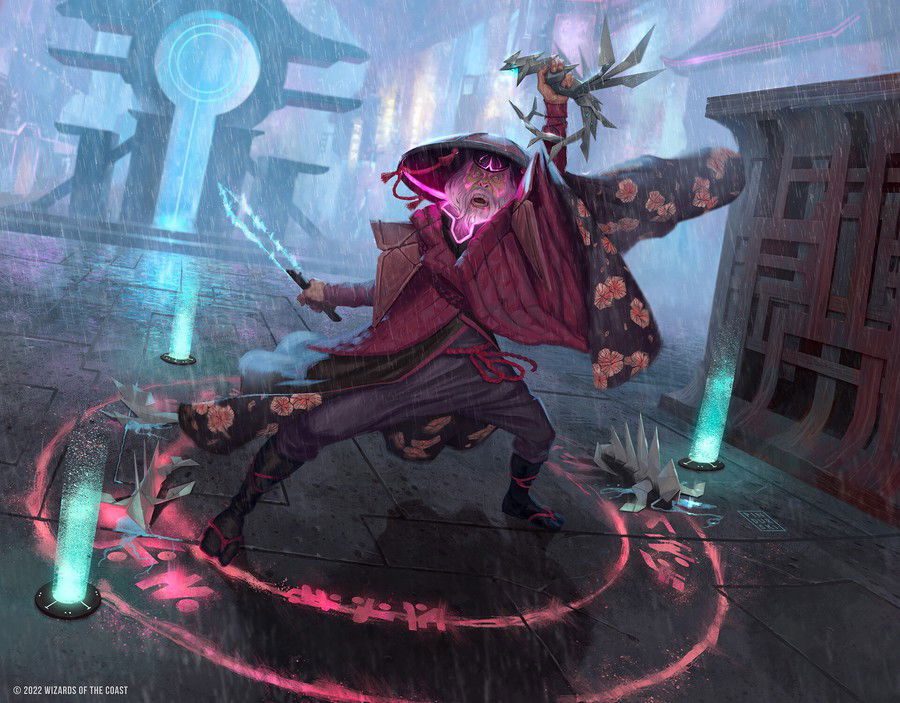
In game terms, consider that tech items are Kamigawa's magic items. They will have the same functionality as magic items from the Dungeon Masters' Guide would have in other D&D campaigns, but will take the form of electronic, mechanical, or other technology.
A healing potion would be a nanoparticle spray that recreates synthetic fabric. A vorpal sword would have a blade edge made of lasers. The winged boots would have antigravity turbines or thrusters instead of wings. Sentient items would possess some sort of artificial intelligence, and the cursed ones could be defective or have been hacked.
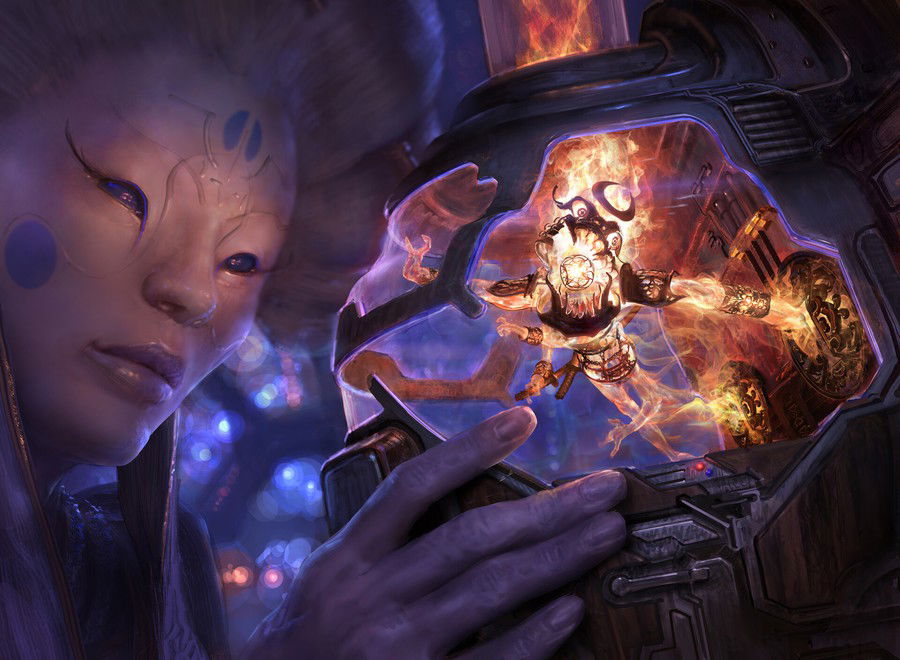
The following guidelines can be used to adapt D&D magic items to the tech world of Kamigawa. They were partially based on the ones found in Plane Shift: Kaladesh by James Wyatt, with some changes by me. Additionally, the card art of Kamigawa: Neon Dynasty and Neon Dynasty Commander provide examples of how you can translate Kamigawa's technological gadgets into magical items for D&D.
Charges: Unlike many conventional magic items that work indefinitely, the technology in Kamigawa is powered by electricity; specifically electricity generated from Kakuriyo's captured spirit energy. A magic item's charges represent this energy in Kamigawa, but charges do not automatically replenish. Instead, an item's owner must store the energy in a battery and recharge the item to replenish its charges.
It is not difficult, however, to get electricity in Kamigawa. Any home in big cities has access to the power grid similar to what we have in our world, so getting power is not a problem. In the case of an item that normally automatically recovers a random number of charges, this random roll can represent the amount of energy that is available to a character on a given day. A character can purchase additional energy (at a night market, perhaps) at a cost of 5 gp per charge. If an item's charges are not automatically recharged, the item cannot be replenished.
Consumable Items: Some technological devices such as are designed to create unique short-term effects that duplicate the effects of potions, scrolls, and similar magic items. These don't take the form of real elixirs or paper spells, but they do have the same effect.
Attunement: The attunement of tech items in Kamigawa largely reflects some hardware limitation or a large need for energy that must be transportable by the character.
Conjuring Creatures: Tech items that conjure creatures can produce automaton robots or drones (which, in Kamigawa, take the form of origami).
Accessibility: Unlike most other worlds, the tech boom of the Modern Age allowed for much greater accessibility of these items to the population. Tech items are much more common in Kamigawa than in most D&D worlds, and are readily available for purchase on the open market. The DM should feel free to be generous in allowing characters access to technology, in the cyberpunk spirit of Kamigawa: Neon Dynasty. Some items are produced in industries approved by the Imperial Court, carefully tested for safety and functionality, and sold at prices ordinary citizens can afford. Others are created by renegade inventors who ignore imperial regulations and sell their devices on parallel markets.
The DM decides whether a certain item is legally available for purchase or not. As a general rule, most weapons and other destructive items are banned under Imperial safety regulations. The following table stipulates a price range for a tech item according to the rarity of its magic equivalent, as described in the Dungeon Master Guide. At the discretion of the DM, items regulated by the Imperial Court can also be found on the parallel market for a reduced price (between 10% and 40% less), but with lower quality or defective. On the other hand, some items, especially the most dangerous ones, can only be found in the underground market, and are always more expensive.
| Rarity | Price* |
|---|---|
| Common | 1d10 PO |
| Uncommon | 1d6 x 10 PO |
| Rare | 2d10 x 100 PO |
| Super Rare | 2d4 x 1.000 PO |
| Legendary | 2d6 x 25.000 PO |
Character Classes in Kamigawa
Here are some considerations for adapting different character classes to Kamigawa: Neon Dynasty themes. The descriptions also feature examples of Magic cards that can serve as visual references to what class members might look like in Kamigawa.
Artificer
Featured in the Eberron: Rising from the Last War campaign setting and later in Tashas' Cauldron from Everything, the artificer class represents engineers of all types of technology in the Modern Age. They are a very suitable class for Kamigawa's setting and conceptually speaking they would be exactly as described in the books, with the appropriate adaptations described previously in "Magic and Technology".
Artificer representations: Enthusiastic Mechanaut, Katsumasa, the Animator, Replication Specialist, Sokenzan Smelter, Scrap Welder.Barbarian:
The barbarians of Kamigawa almost always hail from the Sokenzan Mountains, where they often join bandit clans amid renegade samurai, revolutionary warriors and sorcerers. Many join the Asari Insurgents. The Jukai Forest can also be home to more reclusive barbarians connected to the kami of nature. Overall, they're like the barbarians in any other D&D setting.
Barbarian representations: Godo, Bandit Warlord.Bard
Bards are common in Kamigawa. They are open to the use of technology but are also sensitive to the kami who often provide inspiration for their art. Those with access to technology use devices that aid their performance, such as electric musical instruments and devices, capable of modulating different types of sounds that inspire different emotions. Those more kami-oriented are closer to the traditional bard.
Bard representations: Reki, the History of Kamigawa, Towashi Songshaper, Bearer of Memory, Hair-Strung Koto, Historian's Wisdom, Jukai Naturalist.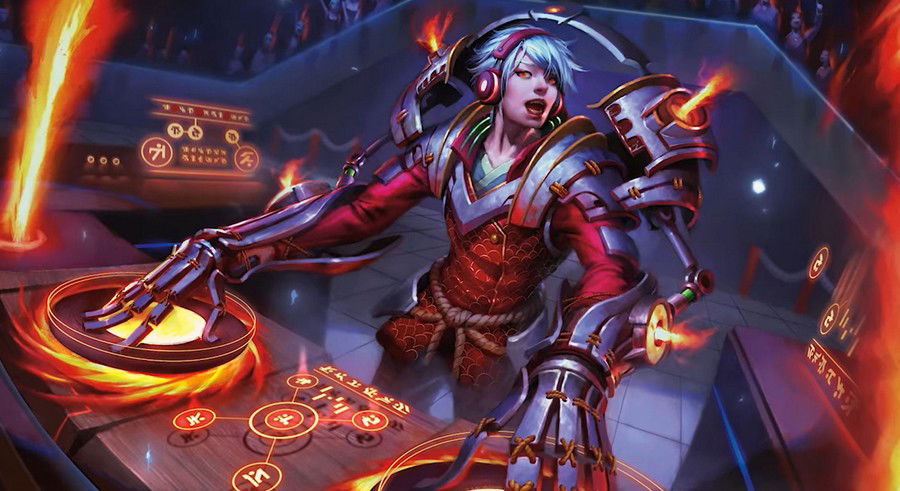
Warlock
Since in Kamigawa every supernatural being is a spirit, it is inevitable that the origin of a warlock's powers always comes from a powerful kami. However, their abilities do not require a personal connection to spirits such as a cleric or druid. Therefore, warlock in general are free to use technology to help them amplify their powers according to their own preferences. Yet, the nature of their magic will always have a supernatural reminiscence.
Most Kamigawa warlocks belong to one of the numerous demonic cults and choose an Fiend as their patron, the best known of which is the oni Hidetsugu, Devouring Chaos.
Warlock representations: Akki Coalflinger, Blood Speaker, Gnat Miser, Ruthless Technomancer, Reckoner's Bargain, Reckoner ShakedownCleric and Druid
In Kamigawa, the powerful kami assume the role that deities and the superior powers of nature would have in other settings, even being able to grant spells to clerics and druids. The divine spellcasters who trace their power through the kami are called kannushi, and can be both clerics and druids. Any cleric domains or druidic circles can be easily adapted to Kamigawa's theme by simply pairing them with a powerful kami that embodies the archetype's concepts.
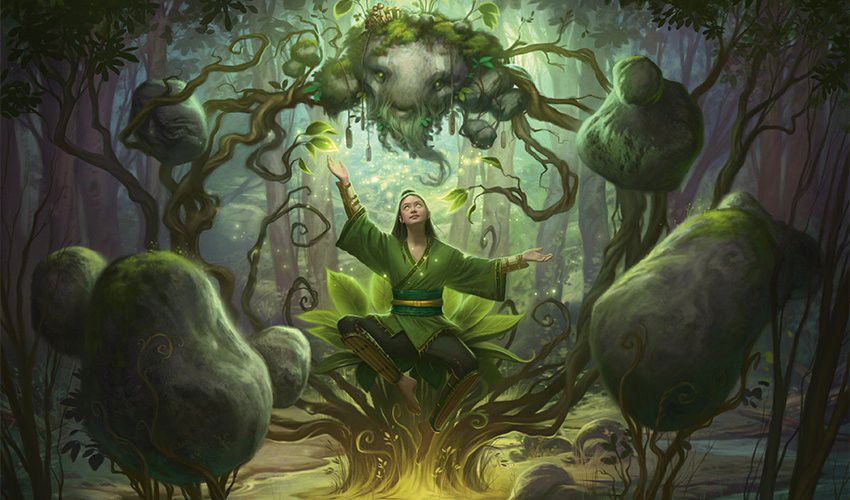
A cleric is a kannushi who employs divine magic in the service of a specific powerful kami, who grants access to its domain. It is therefore evident that members of this class are adept at traditional spellcasting methods. The strict relationship with the kami is the basis of a cleric's magic, and it is impossible to dissociate him from it without losing his powers. Still, a cleric whose patron kami condones technology can also use it.
With the Kamigawa druids, however, things are a bit different. They are closely linked to nature's kami, who by the way are the most averse to the advancement of technology. As such, the use of technological gadgets is often somewhat incompatible with the druid's path, making class members essentially identical to other settings conceptually speaking. However, not all nature-bound kami are entirely averse to technology, so druids who allow themselves to use technology are not impossible, although they are very rare.
Cleric representations: Empty-Shrine Kannushi, Split-Tail Miko, Kitsune Diviner.Druid representations: Jukai Preserver, Satsuki, the Living Lore, Shigeki, Jukai Visionary, Promised Kannushi, Azusa, Lost but Seeking.Sorcerer
In kamigawa, sorcerers are arcane spellcasters with an innate connection to the spirit realm, gained through a mysterious bloodline with ancestral spirits. They never necessarily needed to maintain relationships with the kami to gain their power, but historically, they did because they valued proximity to the forces that gave rise to their gift long ago.
In the Jukai Forest they are as common as the kannushi druids and claim a draconic lineage with the forest's ancestral ryuu — Jugan, the Rising Star. In the Sokenzan mountain range, some sorcerers live as hermits called yamabushi, maintaining ancient shamanic customs. Most, however, embraced modernity and went on to live in cities such as Sokenzan-shi and the Towashi Undercity. Thanks to their innate talent for magic, these sorcerers have managed to adapt perfectly to the modern world, making good use of technology to complement their abilities.
Sorcerer Representations: Sakura-Tribe Springcaller, Gnat Miser, Kumano's Pupils, Kiki-Jiki, Mirror Breaker, Frostwielder, Homura, Human AscendantFighter and Paladin
Fighters are a very present class in Kamigawa, with almost all factions employing members of this class. They are very common in Towashi among the Eiganjo Imperials, and also along the Sokenzan mountain range. Fighters and paladins attached to the Imperial Court are trained in the fortress of Eiganjo in the discipline of bushido and are called samurai. These fighters choose the Battle Master archetype (or the Samurai archetype itself, if you have access to the Xanathars' Guide to Everything) while paladins choose the Oath of Devotion. They serve as the Emperor's elite guard and force and make up the best-trained army in Kamigawa. However, there are also renegade samurai - called ronin - who do not serve the Emperor and live as bandits or revolutionaries in the Sokenzan Mountains. These constitute the majority of the Asari Uprisers faction's forces, and may prefer either the Champion archetype or the Oath of Vengeance.
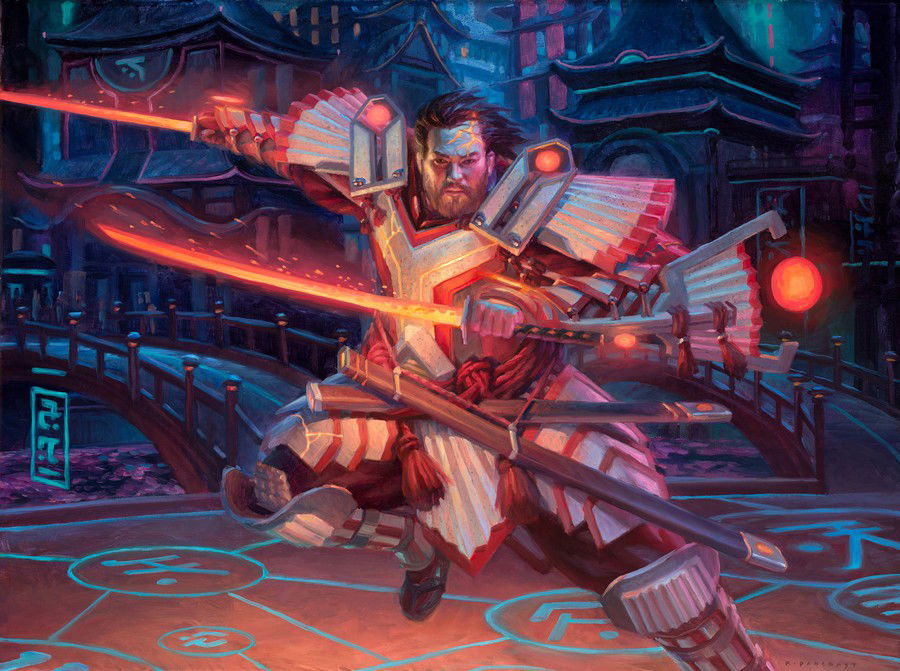
Ranger
The Ranger Class represents a wilderness scout with unique wilderness survival skills and some magical ability. While there aren't many representations of guardians on Kamigawa's cards, the concept of this class is perfectly suited to the setting.
A ranger is more likely to hold a more conservative view of spirits, being closer to the kami of nature and rejecting technology. The Jukai Order, among many other things, is responsible for defending the forests of Kamigawa and preventing intruders from invading. Rangers can be employed in this task of patrolling the edges of civilization in defense of territory claimed by nature kami and their allies.
Ranger Representations: Sakura-Tribe Scout, Matsu-Tribe Decoy, Bamboo Grove Archer, Twinshot Sniper.Rogue
Rogues are easily suited to Kamigawa without needing much adaptation. They are very common in the Undercity of Towashi, where the dark and poorly guarded streets are a breeding ground for illicit activities. Many rogues work for the Hyozan Reckoners and become ninjas, choosing the Assassin archetype or acquiring monk multiclass.
Rogue Representations: Network Disruptor, Okiba Reckoner Raid, Saiba Trespassers, Undercity Scrounger, Covert Technician, Futurist Operative, Moon-Circuit Hacker, Prosperous Thief.Wizards
The Wizards— also called jushi — along with the artificers, are the pioneers of technological evolution in Kamigawa. They are at the forefront of innovation, and are primarily responsible for the vast majority of the technologies that reach the people of Towashi and other major cities.
In the past, however, members of this class studied the kami to channel their power, and used talismans, incense, and other mystical materials to cast their spells. The old tools of the trade were replaced by grimoires-tablets, circuits and gadgets of all kinds. In terms of gameplay, consider that Kamigawa's jushi are like wizards from other D&D worlds, with the difference that they use state-of-the-art electronics as material components and arcane focuses.
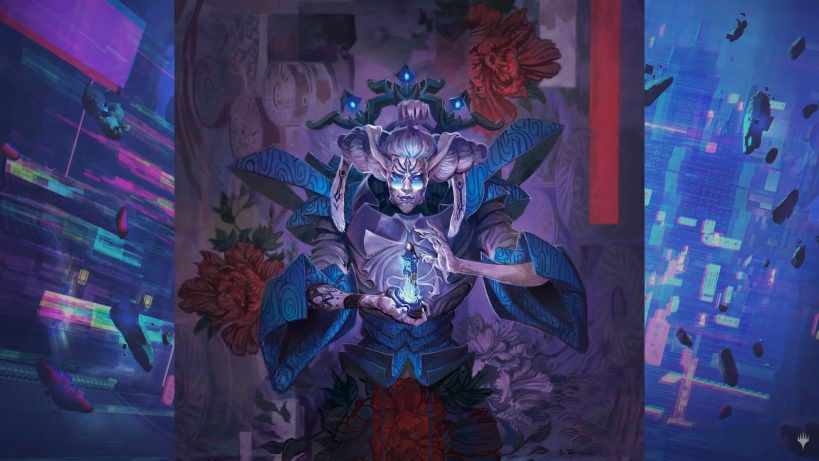
The vast majority of Kamigawa mages graduate from Minamo Academy, and very commonly join the Saiba Futurists.
Wizard representations: Moonfolk Puzzlemaker, Research Thief, Ruthless Technomancer, Tameshi, Reality Architect.Monk
In Kamigawa, monks are very present, treading a variety of martial arts mastery paths. Due to their reclusive natures, there might be a number of orders scattered throughout the wilds and villages of Kamigawa where all sorts of Monastic Traditions are practiced.
The most common, however, are found in the Jukai Forest, such as the Budoka (who practice a life of devotion to nature, choosing the Way of the Four Elements and often becoming a druid multiclass). There are also monks comprising the Living Historians, the Imperial Court (who choose the Way of the Open Hand), and the Hyozan Reckoners (who become ninja by choosing the Way of Shadows).
Monk Depictions: Golden-Tail Disciple, Ascendant Acolyte, Era of Enlightenment, Descendant of Masumaro, Dosan the Falling Leaf, Iwamori of the Open Fist, Rune-Tail, Kitsune Ascendant, Sasaya, Orochi Ascendant, Humble Budoka, Budoka Gardener.Conclusion
We finish the first part of this adaptation of Kamigawa: Neon Dynasty for Dungeons & Dragons. I hope you enjoyed it.
Keep in mind that there is much more to this scenario that deserves to be considered when adapting it for D&D. In part 2 I will bring the statistics of the six playable races for player characters: human, kitsune, soratami, nezumi, orochi and goblin akki.

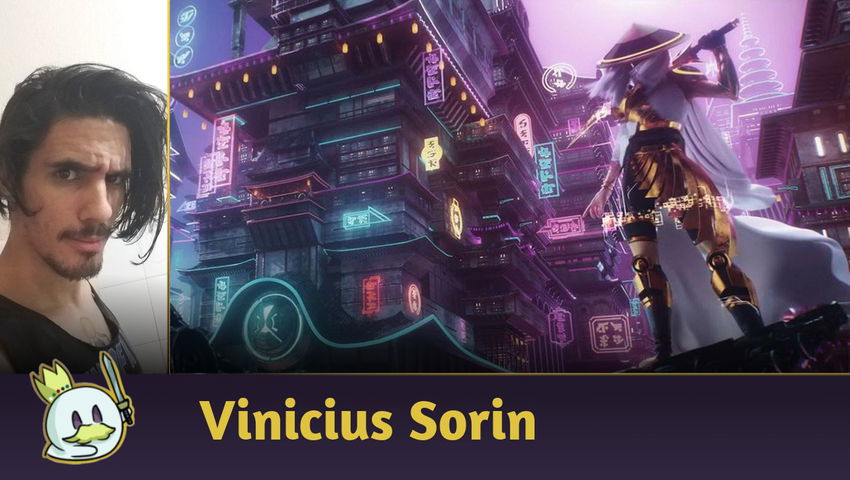







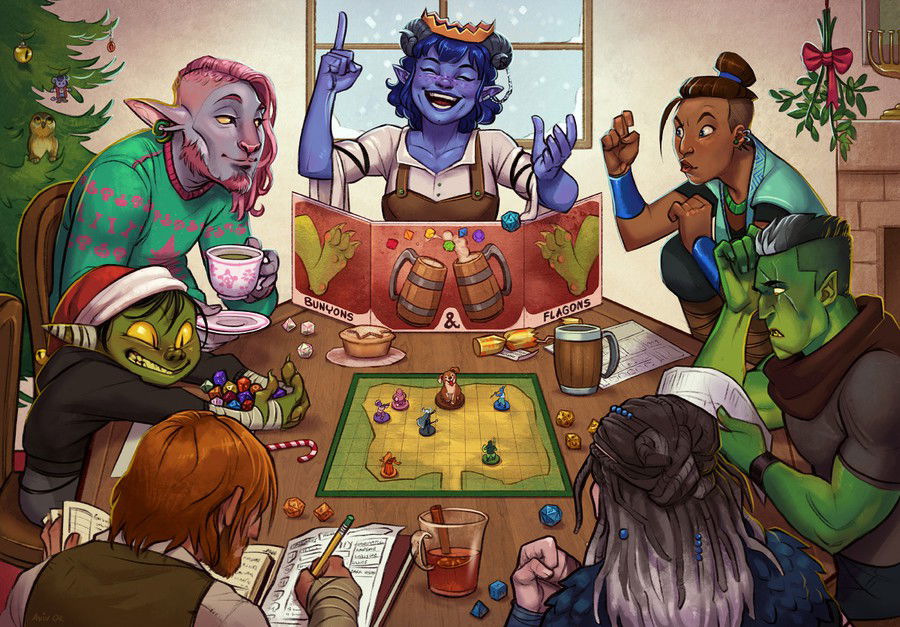
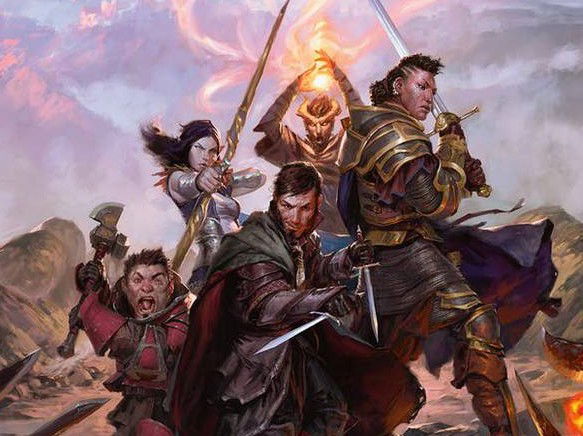



— Comments 0
, Reactions 1
Be the first to comment